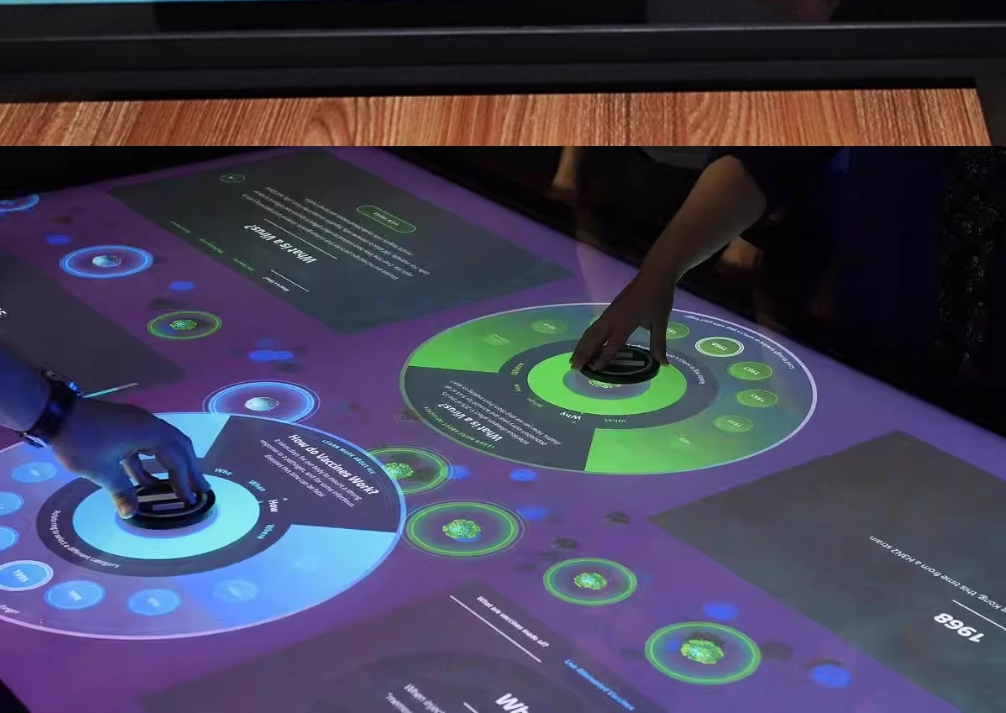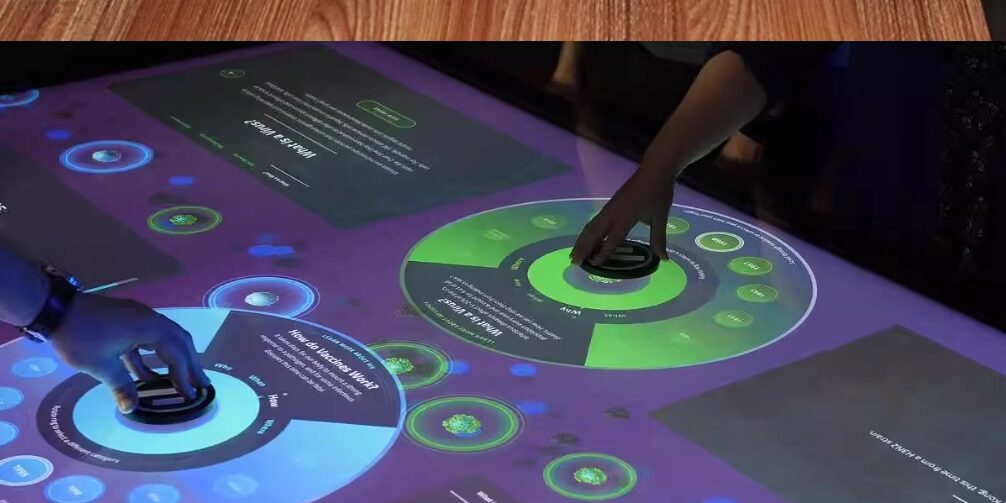Introduction: The Rise of Interactive Tabletop Displays
Interactive tabletop projection systems are creating new and exciting ways for visitors to engage with digital content in public venues. As curiosity about the latest technologies continues to grow, these innovative systems provide a captivating blend of entertainment, education, and information, seamlessly merging the virtual with the physical world.
What Is a Tabletop Interactive Projection System?

A tabletop interactive projection system is an all-in-one solution that brings dynamic digital content to life on any tabletop surface. With the combination of high-definition projectors and tracking technology such as LiDAR, infrared sensors, or capacitive touchscreens, images and videos are projected onto variously shaped table surfaces. Visitors can interact with the displayed content using simple hand movements or touch, resulting in an intuitive and immersive hands-on experience.
How Does It Work?
- Projection Technology: A high-quality projector displays interactive content directly on the table.
- Sensing & Tracking: LiDAR, infrared, or capacitive touch technologies detect gestures, hand movements, or touches on the surface.
- Real-Time Feedback: The system recognizes user actions and responds instantly, enabling actions like tapping images, 3D rotating objects, or dragging and resizing visuals with natural gestures.
Key Benefits of Tabletop Interactive Systems
Unique and Direct Engagement
One of the key points of tabletop interactive projection is its ability to capture visitors’ attention through direct and creative engagement. Whether in museums or entertainment venues, users participate actively rather than passively observing, making learning and exploring more memorable.
Multi-Person Collaboration
Unlike traditional single-user devices, interactive tabletops can support multiple users at once. This makes them ideal for social, collaborative experiences—imagine friends grouped around a table in an arcade or visitors working together in a museum to solve a digital puzzle.
Easy-To-Use and Accessible
The systems are designed for simplicity. Users can control games or explore information simply by moving their hands or fingers across the surface, making them easy to use for people of all ages and backgrounds.
Natural Multi-Touch Interaction
Utilizing computer vision, these systems allow for natural multi-touch and gesture-based operations. Dragging, rotating, and zooming are as simple as performing the gesture on the tabletop, enabling an experience that feels natural and intuitive.
Standby Modes Enhance User Experience
Most tabletop interactive systems include standby animations or videos that play automatically when the system is idle. The system instantly switches back to interactive mode once it detects a touch, ensuring a seamless and engaging experience at all times.
Broad Applications Across Industries
Tabletop interactive projection systems are now widely used in:
- Museums and Science Centers: Engage visitors with interactive exhibits, historical exploration, and educational games.
- Exhibition Halls and Trade Shows: Showcase products and services with hands-on exploration or digital catalogs.
- Retail and Malls: Offer digital product information, wayfinding, and interactive promotions.
- Corporate Lobbies and Conference Rooms: Provide interactive presentations, company information, or advanced meeting support.
- Entertainment Venues: Enable group gaming and social interactions in arcades, themed restaurants, or event spaces.
CPJROBOT: A Leader in LiDAR Innovation
At the heart of many advanced tabletop interactive solutions is LiDAR technology, providing precise and responsive gesture recognition. CPJROBOT is dedicated to the research and development of LiDAR sensors, advancing the capabilities and reliability of interactive projection systems across industries.
Conclusion: The Future of Interactive Table Experiences
As the demand for engaging digital experiences continues to surge, tabletop interactive projection systems offer an innovative, user-friendly, and visually stunning medium for interaction. With companies like CPJROBOT pushing the boundaries of LiDAR and sensing technology, these systems are set to become a feature of modern exhibits, learning environments, and social spaces worldwide.
For the latest in interactive technology solutions and advanced LiDAR integration, explore more from CPJROBOT.







